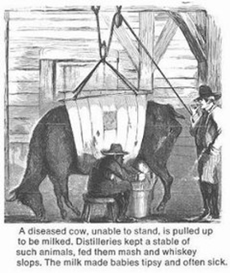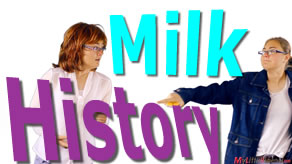
History of Raw Milk
Distillery “Swill” Milk
The early 1800s brought great hope to America. We had officially parted ways from Britain and the industrial revolution was in full swing. New industries were appearing along the east coast. Alcohol Distilleries made their first appearance in the 1820s. The alcohol industry continued to build until the early 1900s. In the mid-1800s, a brilliant idea was formulated that would change the elimination of waste from the distilling process.
Barley is used to make whiskey. Barley was also fed to cattle. The idea was to feed the fermented barley mash (Swill) from the distilling process to the cows. The assembly was elaborate. Cattle were raised next to the distilleries and the swill would convey down an automated assembly line into to their feeding troughs. It was the picture of efficiency.
However, the cattle were confined in poorly constructed shelters and forced to eat food not indigenous to their natural diet. They soon became unhealthy.
A May 1st, 1887 New York Times article titled, “Swill Milk Destroyed”, reported:
"The animals were crowded together in the filthy pens, with scarcely any light and very little ventilation. The floors of the stables were hidden beneath several inches of filth. Which had evidently accumulated for weeks, and the stench in the place was sickening. Then animals are fed on swill, brewers’ grains and other refuse and many of them were tailless, one of the results of the system of feeding and close confinement."
Ultimately, the milk was a bluish color from the lack of cream content. Without the cream, people were unable to make butter or cheese. Imagine no butter or cream for the coffee. This would not be a perfect world for sure.
Milk dealers were trying to fix the problem with additives. On April 30th, 1874, a New York Times article, “Bad Milk” read:
"To remove the sky-blue color, and improve the flavor of the diluted article, dealers found it necessary to add a little molasses to sweeten it, salt to heighten its flavor, and annatto to improve its color. In addition to these substances, chalk, starch, and the brains of different animals are frequently employed to improve the general appearance of the milk."
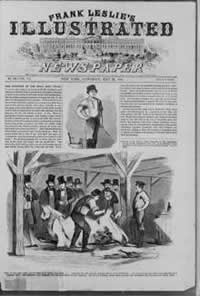 The second issue to the swill milk dilemma was science had not fully uncovered the problem of understanding or eliminating germs. Food workers were not trained in today’s methods of sanitation. Back then, the public knew nothing about washing their hands. Therefore, the milker's hands were not clean and their pails not carefully sanitized. You could almost hear the ticking time bomb for a public health disaster.
The second issue to the swill milk dilemma was science had not fully uncovered the problem of understanding or eliminating germs. Food workers were not trained in today’s methods of sanitation. Back then, the public knew nothing about washing their hands. Therefore, the milker's hands were not clean and their pails not carefully sanitized. You could almost hear the ticking time bomb for a public health disaster.
You may be surprised to hear that distillery “spent grain” is fed to cattle today. The fermented grain contains some health benefits for animals. However, the recommendation for feeding is less than 25% of the overall diet, unlike the 100% given during the distillery boom.
With all these unhealthy cows, you can imagine what was happening especially to the infants drinking the tainted milk. Infant deaths in the late 1800s were skyrocketing. No one, at the time, knew what was causing it. However, some were determined to find out.
Swill Milk Scandal
In New York City 1858, Frank Leslie’s Illustrated Newspaper exposed the distillery dairies scandal, which caused public outrage and pressure on politicians to regulate the industry. Investigations followed but politician Michael Tuomey, successfully argued swill milk was good for children. He made the health officials look ridiculous and succeeded in blocking reform to the distillery dairies. The fight continued for years. Eventually, public pressure and legislation closed 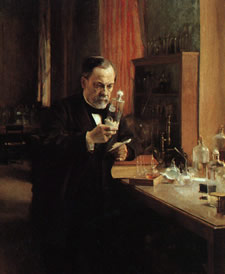 “distillery dairies”. However, strong food handling regulations were not put into place until the 20th century.
“distillery dairies”. However, strong food handling regulations were not put into place until the 20th century.
Discoveries in the Mid-1800s
New discoveries relating to germs were discovered. Two were of particular interest to the
“milk problem”.
The French scientist, Louie Pasteur, developed the “germ theory” in 1862. He found that by heating milk below boiling (pasteurization), he could kill most germs. Pasteurizing killed bacteria, yeast, mold and viruses.
In 1847, a doctor from Hungary, Dr. Ignaz Semmelweis, observed that hand washing would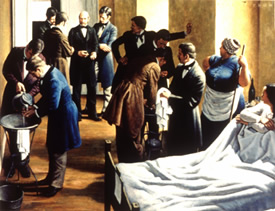 significantly reduce the passing of germs. But it wasn’t until the early 1900s that a campaign was started to inform the public. Leaflets and posters reinforced hand washing. Organizations were advertising soap and doctors’ offices, classrooms, and public lectures provided hand washing information.
significantly reduce the passing of germs. But it wasn’t until the early 1900s that a campaign was started to inform the public. Leaflets and posters reinforced hand washing. Organizations were advertising soap and doctors’ offices, classrooms, and public lectures provided hand washing information.
With the discovery of clean hands came the
media’s fixation on the sensational. At the turn of the century, germs were the talk of the 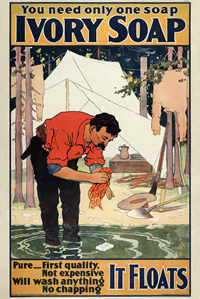 town. Newspapers ran germ stories continuously. Public fear began to rise.
town. Newspapers ran germ stories continuously. Public fear began to rise.
Pasteurization Realized
Nathan Straus, co-owner of Macy’s Department Store, had a heart for the poor. During the depression in 1892, he gave away 1.5 million buckets of coal to the poor to heat their homes.
Tragically, Nathan had lost two of his three children to unnatural deaths. He began to believe there was a connection between raw milk and child mortality. He was convinced that pasteurizing was the solution to the “milk problem”. He opened a pasteurization milk plant in 1893 distributing bottled milk through milk stations in various locations in New York. He gave it away to people who could not afford milk and sold it under cost to everyone else. His philanthropy led to milk stations in several cities. Officials documented a decline in childhood deaths in cities where these depots were located.
Specifically, 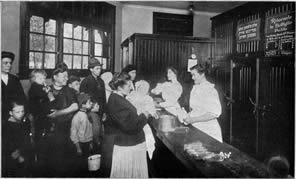 Straus provided pasteurized milk to an orphanage. This particular orphanage had a 42% death rate from milk related diseases. The rate dropped to 28% within a year.
Straus provided pasteurized milk to an orphanage. This particular orphanage had a 42% death rate from milk related diseases. The rate dropped to 28% within a year.
Hidden Consequences of Heating Milk
With pasteurization comes the loss of healthy nutrients. The harsher the cleaning treatment, the more nutrients are lost.
For example, in Berlin, Germany in 1901, an outbreak of scurvy happened within months of implementing pasteurized milk. Raw milk contains as much vitamin C as orange juice but pasteurization destroys 50% of the vitamin.
Vitamin C is not the only nutrient diminished with pasteurization. Here are some other nutrients that are affected:
-50% loss of the Vitamin C
-66% loss of vitamins A, D and E
-100% loss of Vitamins B6 and B12
-Loss of numerous beneficial enzymes, antibodies and hormones
-Specific loss of Lipase enzyme which impairs fat metabolism and the ability to properly -absorb fat soluble vitamins A and D
-Loss of calcium, folate, iron, iodine, and minerals
-100% loss of phosphates, an essential for the absorption of calcium
Certified Clean Raw Milk
Meanwhile, Dr. Henry L. Coit wanted access to raw milk for medical purposes. He based his request on documentation from the 1800s demonstrating a cure for a variety of diseases such as asthma, diabetes, colitis, obesity and tuberculosis.
Further evidence for cures using raw milk came from a book published in 1905 titled, “Milk Diet as a Remedy for Chronic Disease”.
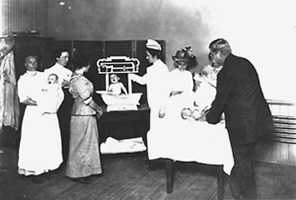 Dr. Coit and a consortium of doctors formed a Milk Commission to “certify” milk for cleanliness. The certification process was extensive. It included testing for diseases in both the animal and the food handler.
Dr. Coit and a consortium of doctors formed a Milk Commission to “certify” milk for cleanliness. The certification process was extensive. It included testing for diseases in both the animal and the food handler.
This is a small section from the milk certification manual of rules for milk handlers:
“The hands of the milkers must be thoroughly washed and scrubbed with soap, running warm water, and brush, and then dried on clean towels immediately before milking. During the handling of the milk, milkers wear clean white suits and caps. While engaged about the dairy, they are not to use tobacco nor intoxicating liquors. They are instructed to keep their fingers away from nose and mouth. No milker is allowed to contact the milk with his fingers or mouth. He may not touch anything but the milking stool, the milk pail, and the cow's teats. No spitting is tolerated.”
Several farmers were motivated to embrace the certification of clean milk. The sale of Safe milk was now available to the public. However, the public paid four times more for “certified clean” raw milk.
Access to Safe Milk
Two solutions were available, “certified clean” raw milk and pasteurized milk. However, when the New York Times ran a story in the 1913 titled, “Typhoid tied to Milk”,  mandatory pasteurization was set in motion. In 1914, New York City began
mandatory pasteurization was set in motion. In 1914, New York City began
implementing compulsory pasteurization and by 1917, most major cities required pasteurized milk.
Cart Before the Horse
Infectious disease rates fell but pasteurization does not solve the entire problem. It doesn't address the entry point of the contamination (the cow & milker). Requiring the sanitization of germ laded food has become the standard governmental policy still in existence today. Should there be more of an effort to work with the source of the problem rather than cooking out germs through heat or radiation?
Why don’t regulations take place up front?
- Our modern day bovine could be tested for diseases and sicknesses beforehand. Oh yeah, they are.
- The cow teats could be cleaned and connected directly to a milking machine. Oh yeah, they are.
- The milk could move through to processing, then bottled. Hands would never be exposed to the milk. It could be completely sealed from the exit of the cow to the bottle. Oh yeah, they already do this.
Pasteurization could be a thing of the past - good for its time but no longer needed. The public could have both safe & nutritious milk.
Growing Movement
Today, a growing number of people are working to inform the public of the health benefits of raw milk (www.realmilk.com).
Similar to doctors at the turn of the century, people today are advocating raw milk fasts for solving several health problems.
(www.thehealthyhomeeconomist.com/the-milk-cure-2012)
(www.cookinggodsway.com/30-day-raw-milk-fast)
(www.rawmilktruth.com/The-Raw-Milk-Cure.html)
Summarizing
The problem of tainted milk was caused by the handling and feeding of milk cows. Discovering pasteurization & hand washing solved the problem of killing germs but didn’t address the feeding and handling of cows. “Certified” milk addressed both the milk and the cow. However, public outcry and fear of spreading germs led to milk pasteurization.
Pasteurization is not a sufficient solution for some of us today. Like the doctors and many farmers at the turn of the century, we are reaching for a higher level of health. Research shows raw milk from grass-fed cows is optimal in nutrients. We want healthy animals, sanitary milking procedures and proper handling of milk for optimal health in both our sweet four legged friends and us.
Behind the Scenes
We decided to add the “why” to our “how-we” videos. Our last few videos have followed this guideline. This video is the “why” to our “Milking a Goat” video. It originally written as one video but after reviewing the clips, two distinct parts emerged - one for the History and another for the Milking.
Characters
Bree’s new “teacher” character, Ms. Rhubarb, was a natural choice for telling the story of the history of milk. The dialogue execution was a challenge. Speaking continually with an English accent was difficult. However, with lots of determination, Bree made her way to the end of the maze.
Bree morphed “Texting Tiffany” into a New Jersey character using John Pinette as her inspiration. “Texting Tiffany” was a mellow character but with this new makeover, she has come alive. She is still blunt, and has that “I’m not interested in what you have to say” attitude but “moving to New Jersey” has really brought her out of her shell. Tiffany gives us some comic relief for this serious subject.
Story Line
Ms. Rhubarb tells the history of milk in a gentle way - her “Britishness” keeps her sophisticated and official. She wants to present history as fair as possible without getting into politics.
Tiffany has no interest in learning the “silly” history of milk. Her only interest is in texting on her iPhone and when Ms. Rhubarb interrupts her, Tiffany is irritated. She tries not to pay attention to Ms. Rhubarb but the story begins to draw her in.
By the end of the story, Tiffany is engaged and ready to fight. She can’t understand why “Milk Politics” is so confusing. She wants answers from Ms. Rhubarb.
It’s hot in the kitchen and Ms. Rhubarb needs to make a quick exit. Her history lesson is over.
These two characters encapsulate our feelings on raw milk. We want to have a balanced assessment and understanding of the history of pasteurization. But there are times when we want to scream from the rooftop, “We live in a free country, what is the big deal about raw milk!”
Gary and Shelly
2/10/2013
Footnotes:
The Untold Story of Milk, Revised and Updated: The History, Politics and Science of Nature's Perfect Food: Raw Milk from Pasture-Fed Cows by Ron Schmid (2003)
Hand Washing http://infectiousdiseases.about.com/od/prevention/a/history_hygiene.htm
Michael Tuomey (NYC politician)
The Fight for Safe Milk: Swill Milk
The Fight for Safe Milk: Pasteurization
Nathan Straus Jewish Virtual Library
1917 INFANTILE SCURVY, V. A STUDY OF ITS PATHOGENESIS, ALFRED F. HESS, M.D., NEW YORK
Raw Milk Truth - The Raw Milk Cure
Farm-to-Consumer Legal Defense Fund







